22nd October 2007
 Sunday, November 18, 2007 at 09:24AM
Sunday, November 18, 2007 at 09:24AM We were back with the dead buffalo at 8am, to find the crocodiles sniffing around the carcass and starting to rip it apart. Overnight the carcass had drifted slightly downstream, but was now caught on another sandbar, halting it on its journey downstream. Because the light was directly behind the scene, it was impossible to take any decent photographs, as all you could see were silhouettes. There were some enormous crocodiles already out sunning themselves on the sandbars, as if just waiting for their moment to gorge themselves on this free meal. The hippos were there as usual too, and unconcerned both by us and the crocodiles – or so it seemed. The impala herd which we often see on our sand bank were in the undergrowth beneath the doum palms when we arrived at the bend in the river, and the birds were all in full morning-throttle – we resolved to come down to this particular spot more often in the mornings – it is truly like Eden recreated…
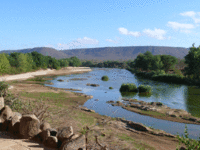
Athi River, looking upstream from the house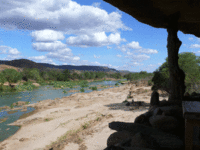
Athi River - view downstream from our balcony
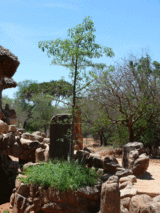
Transplanted Baobab by Ramp leading to our Front Door
Later on in the morning, I went around and photographed various aspects of the garden – mostly the trees which we brought in from surrounding areas and planted – all indigenous species to this part of Kenya. My photos bear witness to the new shoots and sprouting leaves that show the trees are starting to settle into their new surroundings – some were so big when we transplanted them, they had to be brought in by tractor! In my Tree Watch gallery, you’ll see my photos of the Baobabs, Terminalia and Sterculia, as well as some Fig Trees.
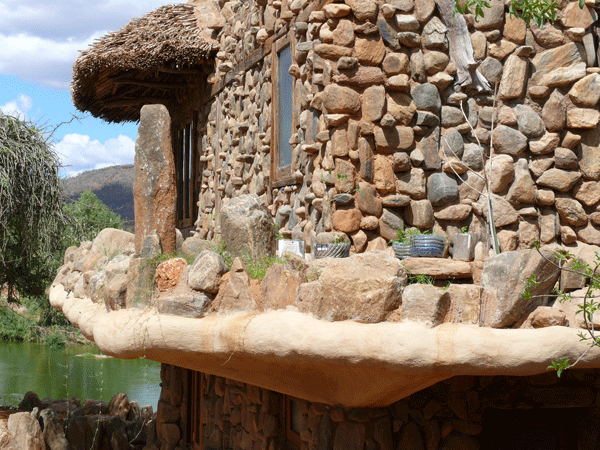
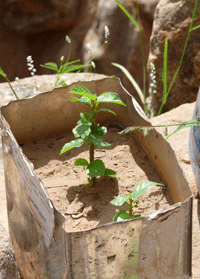 Last month, I collected several tiny fig tree shoots from the riverbed, and planted them out in a small nursery with the idea of re-planting them on the bank below our house as soon as they are big enough. However, the dik-diks invaded my nursery and ate all the new leaves, leaving just the tiny bare stems, so my nursery has now been moved onto the balcony at the back of the house – out of reach of miniature marauding antelope!
Last month, I collected several tiny fig tree shoots from the riverbed, and planted them out in a small nursery with the idea of re-planting them on the bank below our house as soon as they are big enough. However, the dik-diks invaded my nursery and ate all the new leaves, leaving just the tiny bare stems, so my nursery has now been moved onto the balcony at the back of the house – out of reach of miniature marauding antelope!
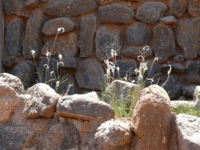
Grasses backlit in upstairs balcony flowerbed
The grasses in the balcony flowerbed also look pretty as they start coming into seed. I have also recorded the first stirrings of life amongst some of the lilies we planted in one of the flower beds on the balcony – the bulbs which are finally sprouting were planted many, many months ago. We’re really excited to see them finally coming to life. You can follow their progress in my Lily Story photo gallery.
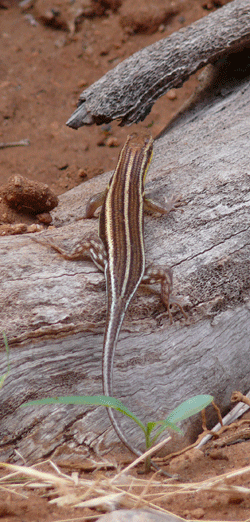
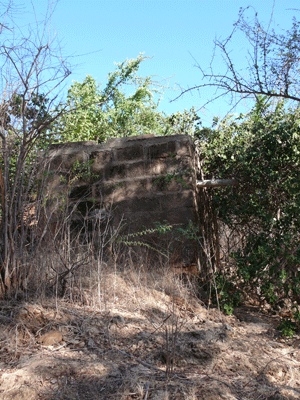 While I was photographing the lilies, one our resident stripey skinks passed by, so I snapped a quick shot of it too on its insect-seeking rounds. This is a Rainbow Skink – the males are glossy and brown, while the females and juveniles have bright blue tails and stripey heads. No doubt you’ll think I’m mad, but I’ve also been photographing small patches of grass, and our bare and barren Hippo Lawn – you may well laugh now, but when the whole area is grassed over, and the hippos and buffalo are grazing there, it will be fun to see how it all started from small, carefully nurtured beginnings! OK, so maybe I really am crazy, but I even took a photo of our septic tank – it’s a good example of how, when you live in the bush, you have to be completely self-contained, whether it be supplying your own power or building your own water, drainage and sanitation systems…
While I was photographing the lilies, one our resident stripey skinks passed by, so I snapped a quick shot of it too on its insect-seeking rounds. This is a Rainbow Skink – the males are glossy and brown, while the females and juveniles have bright blue tails and stripey heads. No doubt you’ll think I’m mad, but I’ve also been photographing small patches of grass, and our bare and barren Hippo Lawn – you may well laugh now, but when the whole area is grassed over, and the hippos and buffalo are grazing there, it will be fun to see how it all started from small, carefully nurtured beginnings! OK, so maybe I really am crazy, but I even took a photo of our septic tank – it’s a good example of how, when you live in the bush, you have to be completely self-contained, whether it be supplying your own power or building your own water, drainage and sanitation systems…
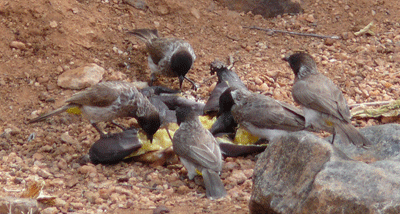 We had the regulars in attendance today at my bird feeding site, just outside the kitchen window – a huge mass of Bulbuls, over-excited by the old bananas I had put out for them, plus Village Weavers, Sparrows and Starlings. The Squirrels were there too, tucking into the fresh fruit leftovers. All the birds made a fuss and a great noise when ‘Slim’, the black-tipped mongoose arrived to collect his chicken bones, but they’re not really in any danger from him. Nonetheless, they sit above him in the bushes and shriek at him, poor fellow…
We had the regulars in attendance today at my bird feeding site, just outside the kitchen window – a huge mass of Bulbuls, over-excited by the old bananas I had put out for them, plus Village Weavers, Sparrows and Starlings. The Squirrels were there too, tucking into the fresh fruit leftovers. All the birds made a fuss and a great noise when ‘Slim’, the black-tipped mongoose arrived to collect his chicken bones, but they’re not really in any danger from him. Nonetheless, they sit above him in the bushes and shriek at him, poor fellow…
See more pictures of birds in and around our home...
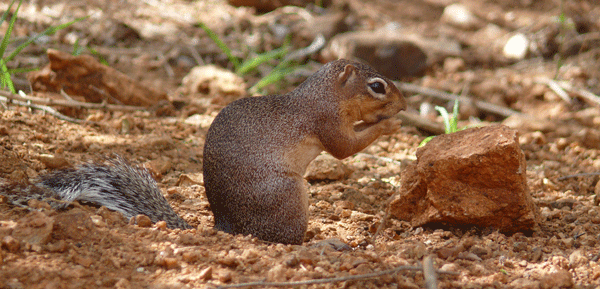
See more photos of small animals like squirrels, skinks & lizards in and near our house...
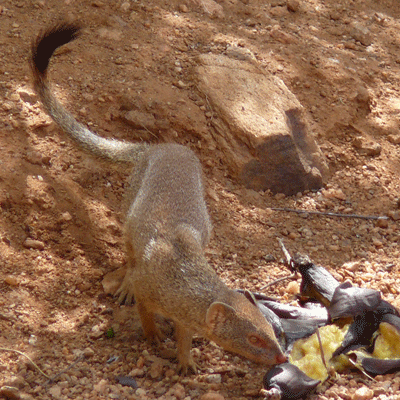
See more photos of Slim, the black-tipped mongoose...
At midday, with the sun directly above us and sweltering hot, we ventured back to the baking sandbank and discovered the buffalo carcass had drifted some way downstream again, but now was being heartily tucked into by a couple of crocodiles. The buffalo’s skin was starting to turn white – perhaps as the fur started to fall out in the water – or perhaps this was where the top layer of skin had come off, revealing the fatty deposits beneath?
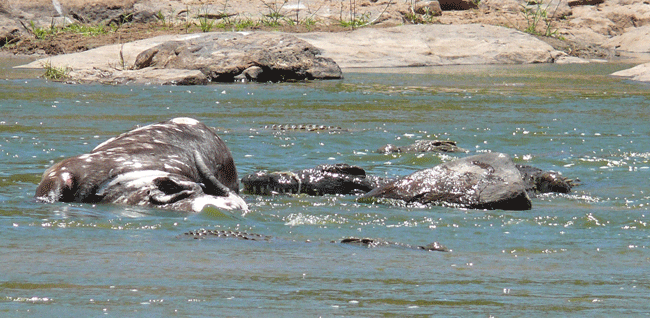
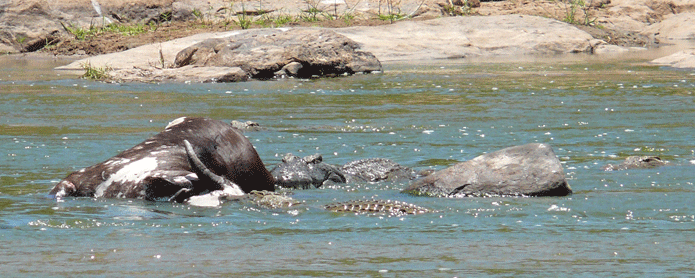
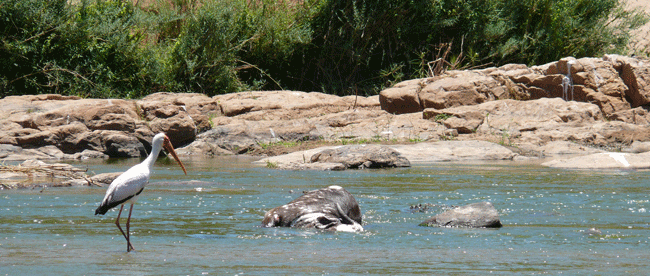
A couple of curious Yellow Billed Storks were hanging around, perhaps hoping to catch some fish attracted to the carrion, but the rest of the flock seemed uninterested, and chose instead to preen themselves on the sandbar to our left.
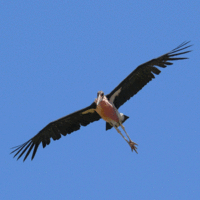
Marabou coming in to land
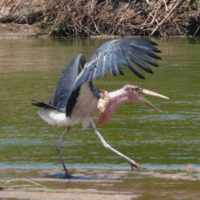
Marabou Stork Lands near Carcass
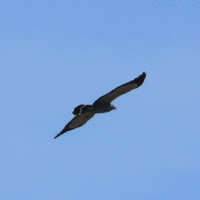
Gymnogene Fly-Past
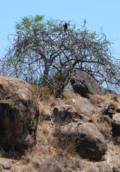
Fish Eagle Watches...
Then a Marabou Stork arrived to have a look around – you can’t keep them away for long, they always want to be in on the action, especially if there’s a chance of scrounging a free meal. I also spotted the Fish Eagle in a tree looking down on us from the far side of the river, and later a Gymnogene flew over, on his way to landing further downstream, probably in search of a few frogs for lunch…
See more Photos of resident Kulafumbi birds...
See more Photos of crocodiles at midday, starting to scavenge on the buffalo carcass...
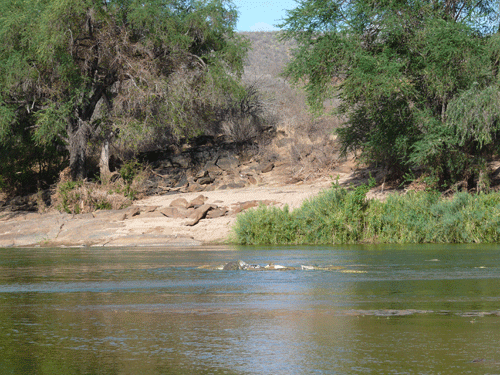
By five in the afternoon, the buffalo carcass had drifted down almost to the house, and so, from the house, we just walked down the sandbank a little way and positioned ourselves behind a conveniently situated rock, which allowed us to watch the proceedings from quite close, without scaring away either the crocodiles or the birds.
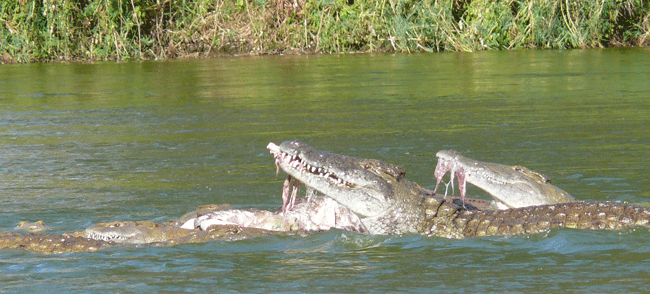
By now, the river had become quite infested by crocodiles, and the carcass was systematically being torn apart, limb from limb. There must have been at least ten crocodiles feeding at any one time, and another ten either lurking nearby, on their stealthy return for more. Every now and then, one of the bigger crocodiles would steal away with a whole leg, or the compete stomach of the buffalo, and swim away from the crowd to enjoy his prize away from the melée.
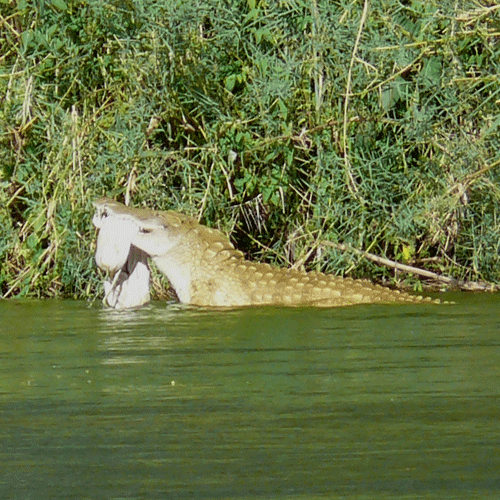
Crocodiles cannot chew – so when the meat they are eating is fresh, they have to bite onto a piece and then spin until the meat rips, and they can swallow the piece whole.

It’s actually quite chilling watching these monstrous cold-blooded, cold-hearted reptiles that have survived on earth for millions of years – since the dinosaurs in fact – tearing to pieces their victim. The way they slither and slide around the carcass, and clamber over one another, and seem almost to be grinning as they set about their morbid meal sends a shiver down my back. And what’s most hair-raising of all, is that when they choose to, they just slide back into the water, leaving a momentary ripple, and then they’re gone – had you not seen the massive beast with your own eyes, you would never have known that seconds beforehand, a huge crocodile was there – now it is lurking beneath the water and you have no way of knowing where it’s gone…
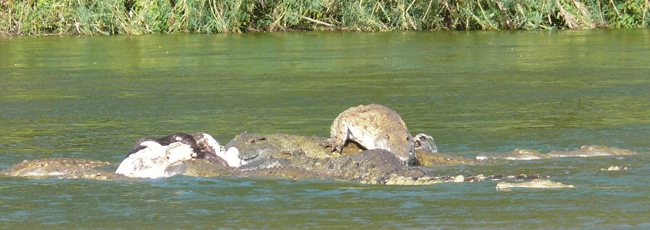
It’s fascinating how paradise harbours these events, which seem so barbaric and cruel. But of course, like other scavengers, the crocodiles are playing a vital role in nature, by cleaning up the carrion, and ensuring that by eating the flesh of dead animals, the meat does not rot for long and spread disease.
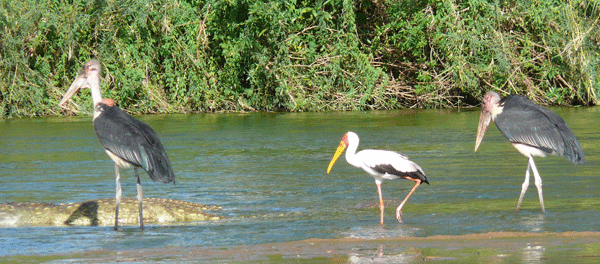
I enjoyed watching the other animals and birds too – the growing flock of Marabous who stood around hoping to snatch a morsel here and there, and the single Yellow Billed Stork, more interested in catching fish coming to nibble at the carcass than scavenging. The Marabous made me laugh, as you could visibly see them plucking up enough courage to approach the buffalo carcass and the seething mass of crocodiles. The storks would get right up next to the crocodiles, and then either lose their courage and skulk away, or suddenly jump in the air with fright as one of the crocodiles made a sudden move.

Got something!

Plover unphased by crocodiles in water behind

Black Storks in front of House
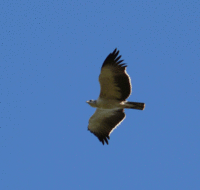
Juvenile Wahlbergs Eagle
The Spur-winged Plovers were also down on the beach, as usual (and completely unphased by the crowd of crocodiles lurking in the water behind them), as were a pair of Three Banded Plovers, rushing around and picking at worms and insects in the mud at the edge of the river. Three Mousebirds flew overhead – I’m not sure whether they were the Speckled or the Blue-Naped variety as I only had a couple of seconds to see them – either way, they’re a new addition to the Kulafumbi bird list! A young Wahlbergs Eagle, with that characteristic square tail, was flying around too, and I got a quick shot of him as he passed overhead. I photographed some Black Storks with our house in the background – it’s not a particularly great shot of the house, which looks a bit dark and gloomy, but fun nonetheless to have a photo of these rare and shy storks in front of the it. The Impala were back down on the sandbank again, nibbling at the new grass, which was lovely to see, especially as they’ve been absent for a few days.

Egyptian Goose Family
And finally, on our walk back up to the house, we passed “our” Egyptian Geese – the ones who live on “our patch” - still with all six goslings, clever things. Yesterday, I was amazed to see the juvenile Martial (which a couple of days ago had killed a dik-dik, which is much larger prey than a gosling) landing right next to the goose family, and the adults taking absolutely no notice. With such complacency, how on earth have they managed to raise all six goslings so safely and successfully? (No doubt, they know more than I about these things!) The goslings are growing up so fast now. Having followed them from the very first day they left the nest, just tiny little bundles of fluff, to near adulthood, it will seem a sad day when they finally leave this stretch of river, and leave just the parents behind to start all over again…truth be told, they will actually be chased away by their parents once they are old enough to fend for themselves and “go forth and procreate”…
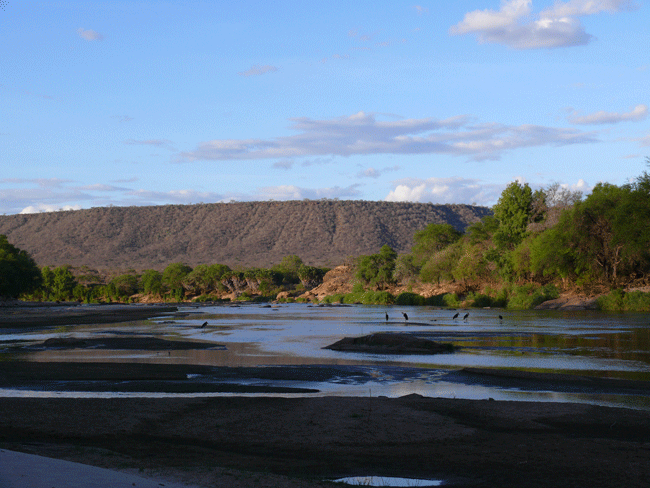
See more evening crocodile shots...
 Post a Comment |
Post a Comment |  Tanya | in
Tanya | in  "Our" Egyptian Goose Family,
"Our" Egyptian Goose Family,  Animals In House,
Animals In House,  Balcony Garden/Flowerbeds,
Balcony Garden/Flowerbeds,  Big Game (general),
Big Game (general),  Birds (eagles),
Birds (eagles),  Birds (general),
Birds (general),  Buffalo,
Buffalo,  Crocodiles,
Crocodiles,  Flowers,
Flowers,  Garden Trees & Plants,
Garden Trees & Plants,  Lizards,
Lizards,  Mongooses,
Mongooses,  River Level Low,
River Level Low,  Slim, the Black-Tipped Mongoose,
Slim, the Black-Tipped Mongoose,  Small Animals (general),
Small Animals (general),  Squirrels
Squirrels 




Reader Comments